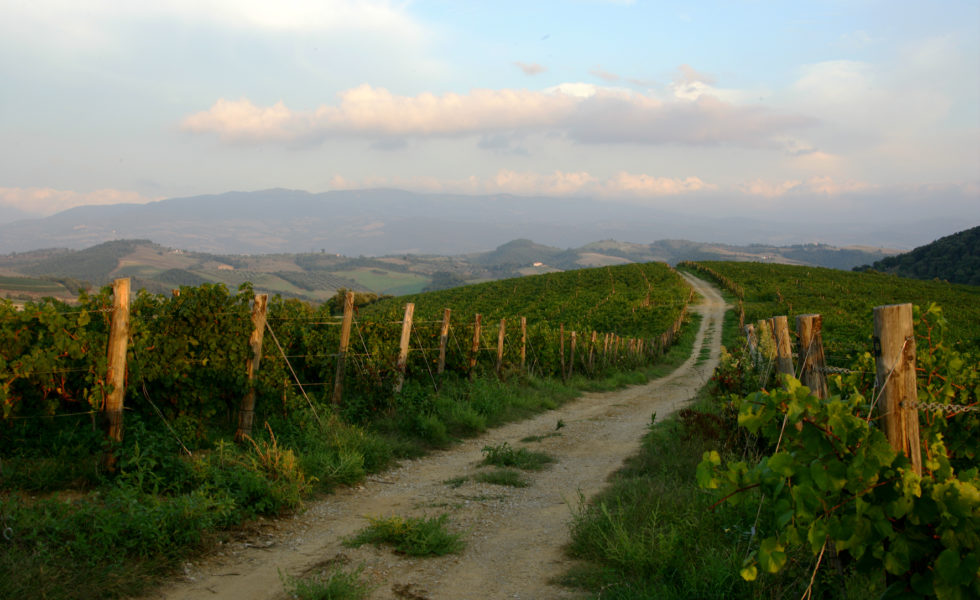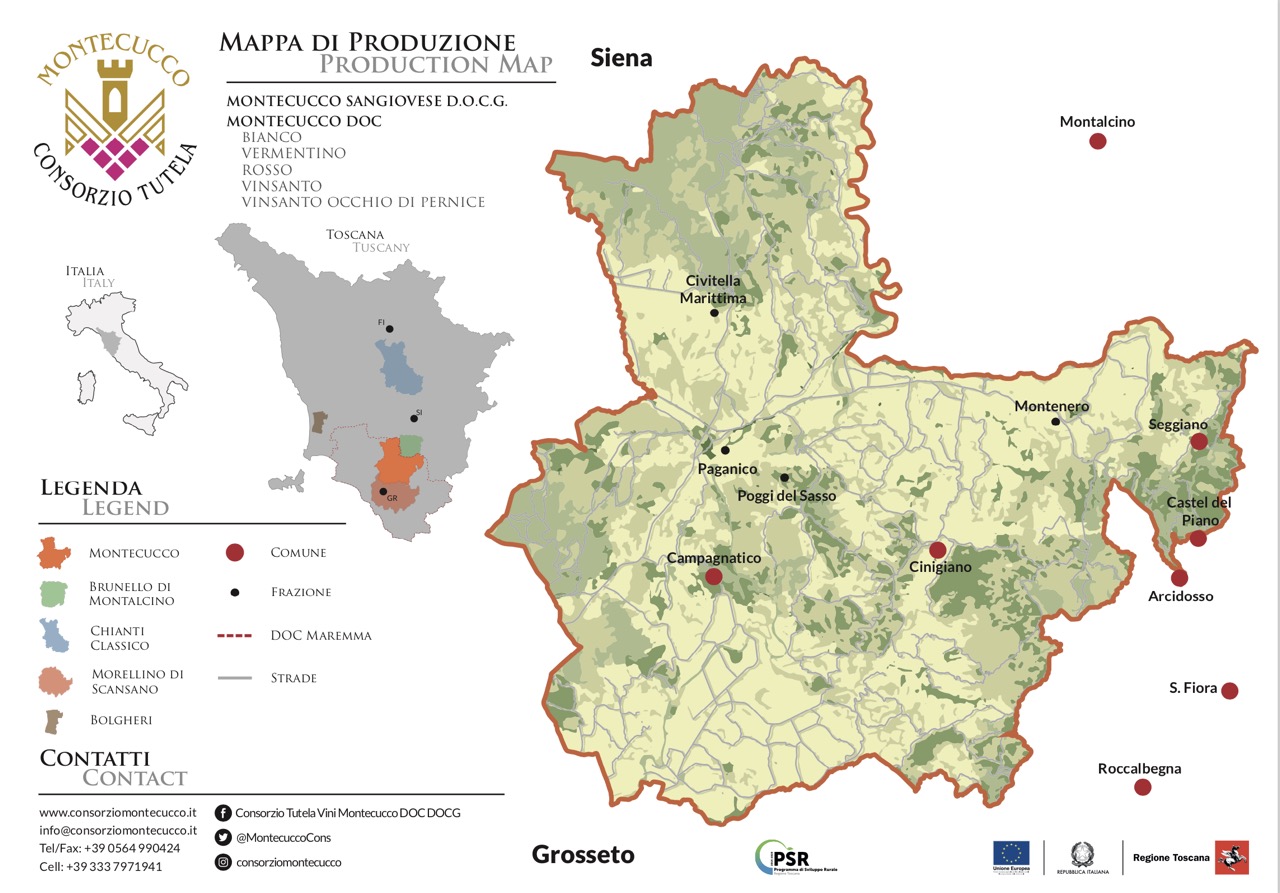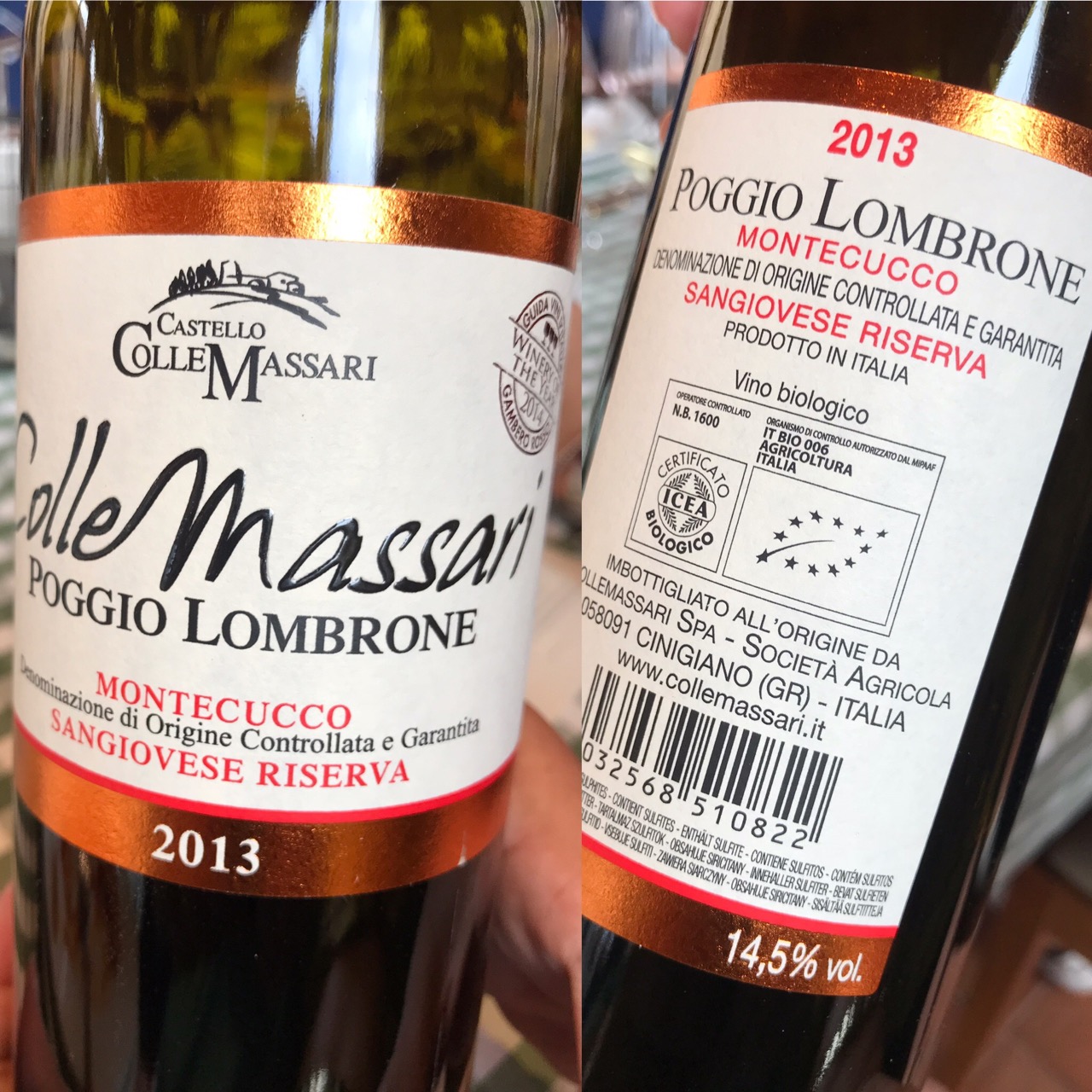Montecucco charm and quality

Or why I should have visited Tuscan vineyards earlier
30 November 2018
By Panos Kakaviatos for Wine-Chronicles
This is Part I of a three-part article on the Montecucco DOC of Tuscany
A three-day, deftly packed visit of wineries earlier this autumn, with comprehensive tastings of Montecucco in Tuscany, proved one of the best wine tours ever. And it revealed Sangiovese-based wines of remarkably fine consistency, at competitive prices. Not to mention some other excellent wines from both white and red grapes.
2018 marks 20 years of the recognition of Designation of Origin of Montecucco Wines so it was great to have been invited and met friends both old and new to mark the occasion.
We were joined on several occasions throughout the visit by Claudio Carmelo Tipa, president of the Consortium for the Protection of Montecucco Wines, at his Colle Massari Tenuta di Montecucco estate starting on Thursday 20 September for visits and tastings.
A quick history
To briefly recap the history of this niche region, it was only at the end of the 1990s that the the DOC Montecucco began, thanks to some young winemakers and their Sangiovese, which comes to life where the Maremma Toscana gives way to the slopes of the Monte Amiata, just in the middle of the Brunello di Montalcino and Morellino di Scansano’s DOCGs.
Seven municipalities are registered – and guaranteed since 2011 as DOCG Montecucco Sangiovese – with designation of origin: Arcidosso, Campagnatico, Castel del Piano, Cinigiano, Civitella Paganico, Roccalbegna and Seggiano.
The consortium counts 66 member wine producers, spanning 800 hectares of vineyards, 500 of which are destined to the DOC e DOCG, and wines obtained through one of the lowest yields per hectare in Italy.
Leave aside the unfortunate 2017 harvest, which in Montecucco yielded losses of between 30% to 50%, the DOC and DOCG since 2012 have seen a steady growth of yield: in 2016 the appellation almost doubled production from the last three years.
Point about food and wine in Tuscany
Before we get to some of the wines, this trip showed how well Tuscan foods pair with local wines.
Two out of three comprehensive tastings – each 20+ wines! – were over dinner, as wine should be appreciated. Tuscans know how to eat. They give us Greeks a run for the money. Indeed, check out this reaction over lunch at Pianirossi Winery by celebrated sommelier and actor Charlie Arturaola who took part in the tour. (see video).
Indeed, the foods deserve a separate blog entry, but a few highlights below, which I will revisit in subsequent posts on Montecucco covering winery visits.
- Slow-cooked venison, with pepper and cardamom among other spices that proved irresistible even after having had other courses of food … (Pianirossi Winery)
- Fabulous pici pasta, perfectly al dente with a subtle sauce and roe meat, of which I could not get enough (Tenuta l’Impostino)
- Grilled wild boar(Tagliata di Manzo) with balsamic vinegar icing (Tenuta l’Impostino) – Of course wild boar is all too common in the region, devastating vineyards, so vintners are all to happy to get those boar hunted down, with the added benefit that they taste yummy.
- Traditional bread and tomato “soup” but so thick that it was formed into a circle – and delicious (Tenuta l’Impostino)
- Tagliatelle ai funchi porcini: Twas’ mushroom season in late September. Combined with homemade pasta, this was scrumptious. Most indulged second servings (Tenuta di Montecucco)
- Tagliata di Chianinawith red radicchio and Pecorino cheese: This tender grilled Tuscan beef – chianina– perfectly prepared, although the melted Pecorino cheese was done “for Americans” remarked several Tuscan winemakers. “Philadelphia cheese steak”, joked one. Whatever the interpretation, this was excellent, as were the savory roasted potatoes. (Tenuta di Montecucco)
- Tiramisu. Yes, tiramisu! So fresh, so creamy, so vividin flavor. Consistent in texture – never runny and just easy to gobble up, which many of us did. (Tenuta di Montecucco)
- Cappuccino at a tank station, on the way to the Tenuta di Montecucco. I am serious. Living in France, where most of the coffee is dark, hard and bitter, it was a relief to enjoy smooth and delicious cappuccino. Now, not every coffee you get in Italy is going to be great, but on average you are happier when with coffee in Italy than in France.
Many wines we tasted were of excellent quality, ranging from merely good to excellent and a few truly great wines. This is part I of a three part series on the wines, and focuses on the first domain that we visited. Parts II and III will address the others.
Tenuta di Montecucco
First off, the Tenuta di Montecucco, where we checked into our rooms in a gorgeous setting, 300 meters high amidst Tuscan hills with breathtaking views. It used to be a small village, complete with a chapel. In the 19thcentury there was a school here. At Tenuta di Montecucco, we enjoyed a fine opening lunch and later two dinners – including the gala closing dinner – where we tried many wines. Owner Claudio Carmelo Tipa is also president of the Consortium.
The estate is a typical example of old Maremma farms: a group of stone buildings and its country villa form the old village of Tenuta di Montecucco with a small church in the centre. The estate has a historical cellar from the year 1300. A large park with olive trees surrounds the swimming pool overlooking the enchanting Ombrone Valley, showing the outlines of the Montecristo Island in the background.
Anyone visiting the region should stay here as the property features 12 apartments of different sizes, composed of double rooms, bathrooms with showers, a living room and a kitchenette.
Thanks to Laura Breschi – pictured, above – we visited his Castello Colle Massari winery, which is now under the same ownership as the Tenuta di Montecucco, about a 15-minute (brisk) walk away (we took the bus). Founded in 1998, it is part of the Montecucco DOC area in Upper Maremma, situated in the foothills of Mount Amiata, between the DOCG areas of Brunello di Montalcino and Morellino di Scansano.
The domain is huge, extending over nearly 1,200 hectares, over 110 of which are under vine, nearly 60 growing olives and approximately 400 dedicated to mixed crops. The rest is forest… The land is situated at over 300 meters above sea level with an average 15% incline and is orientated towards the coast, meaning consistent ventilation and strong thermals.
Modern winery
Part of the appeal comes from the modern architecture winery, built back in 2000 and fitting in neatly with the old, timeless landscape. It was named “Winery of the Year” in 2014 by the Vini d’Italia Guide Gambero Rosso in part because it adheres to certified organic guidelines. It was designed by Edoardo Milesi, an award winning architect, whose firm also designed in 2015 the Forum Fondazione Bertarelli, a music hall and auditorium.

Gorgeous underground cellars of Castello Colle Massari
During the visit to the recently constructed winery, we learned from Laura that Claudio was an engineer who had worked on security systems at the Rome airport. His wife Maria had worked for a travel agency in Rome. Meeting both Claudio and Maria was like the entire experience in Montecucco : gracious people as well as excellent wines.
Some wines over lunch
As usual, wines I like in particular in bold and those even more are red and bold.
Castello Colle Massari Melacce Vermentino 2017 DOC – What a pleasing white, this certified organic 100% Vermentino. Made from two selections, with the second choosing only best grapes then slow fermentation at 15°C. Love the white pepper and white flower aromas with a “perky” aspect to the palate displaying fine acidity. And a nice contrast to the estate’s “bigger” white, the Irisse, reviewed at the end of this section. Rather subtle wet stone aspects, too, on the palate, which is creamy yet with energy. Retails in the U.S. for about $19.
After the fine white, we tried several reds. Although there was a misstep for me – the Colle Massari Montecucco Riserva DOC 2015, with somewhat hard tannin perhaps coming from Cabernet in the blend – I really enjoyed the easy drinking Rigoleto Montecucco Rosso DOC 2016, which is pleasing blend indeed of 70% Sangiovese, 15% Montelpulciano and 15% Ciliegiolo, that last grape a new discovery for me. Ciliegiolo in Italian means cherry, and the grape makes light, fruit driven wine, but not that structured, and tends to be used as a blending grape, also for the color. As for the wine, like Melacce, the Rigoleto names a river near the vines. Aged 10 months, half in steel and half in barrels, this wine yields a rather complex nose of, well, cherry invoking Pinot Noir like elegance, many of us agreed. Easy to drink however and for the price (about $10), a great deal!
But then came the excellent Castello Colle Massari Poggio Lombrone Montecucco Sangiovese Riserva 2013 (DOCG). Certified organic, this 100% Sangiovese was aged three years in big oak barrels and two more in bottle before being released. Vines come from a two-hectares monopole vineyard and the fresh earth “barnyard clean” aspects are complemented nicely with ripe cherry and some crushed tobacco, with a pleasing bitterness on the long finish. It has the elegance of the Rigoleto, but with more substance on the palate. The 14.5% alcohol is not too evident as fine acidity balances things nicely. And you know what? For under $30 retail, this constitutes a bargain. Apparently the wine is sold very much in Switzerland and in the U.S. but also in Japan and in other parts in Europe (the domain exports about 60% of its wines).
I only later looked at the back label to see 14.5% alcohol, somewhat surprised. Sure, this barrel aged blend of 85% Vermentino and 15% Grechetto from the 2016 vintage was thicker in texture, but it did not overwhelm the palate. Enjoyed at the final gala dinner – more on that in a later section – this was a very pleasing drink indeed. Certainly more “intense” than the Melacce, this white remains rather elegant despite the higher octane. And the oak – as can be the case with too many whites – does not obstruct the fruit. Juicy white stone fruit, a bit of orange melon make it very fruit driven but with enough acidity to lend it grip and never feel heavy. There is a touch of dried herb on the finish that make it interesting and certainly a wine to enjoy with a meal. Bravo then to this Castello Colle Massari Irisse Vermentino 2016 DOC.
Seamless organization
Hats off then to both the Consortium for the Protection of Montecucco Wines and to Valentina Fraccascia of the PR agency ZedComm, who did a great job to make the many journalists who came from the U.S. and Europe feel comfortable, while packing in loads of information and tastings.
In the next two parts I will focus on the many more wines that we tasted, and which we found pretty darn good, as you can see in the above video with award-winning wine blogger (The Wine Chef) Lisa Denning and myself.
Throughout the visit – from the moment we met fellow American wine writers, who had just flown into Rome on Thursday morning 20 September, to a gala dinner two days later to celebrate 20 years of the Montecucco DOC at the gorgeous Tenuta di Montecucco – it was seamless.
Several Italian journalists as well as two European participants (Lisa Riley of Harpers Wine & Spiritand Kevin Gagnon, blogger and Italian Wine Ambassador, based in Germany) joined us Thursday evening and Friday morning.
Valentina divided us into three sub groups for wine tours, so that each sub group visited three wineries per day: an ideal number as each sub group of about eight people would have enough time to learn about each winery, without getting too tired (shout out to wine tour organizers: three per day is the right number). If it had been four, we probably would have not been able to pay enough attention to the fourth. The second visit included lunch at the winery.
Stay tuned for Part II to focus on the above tours and many more wines tasted.
 Wine Chronicles
Wine Chronicles










Share This